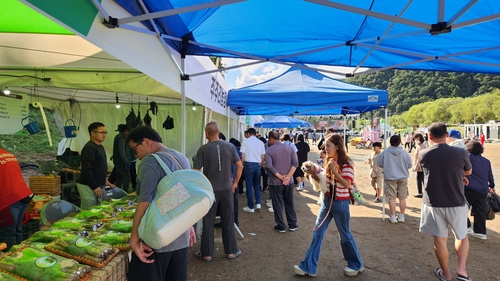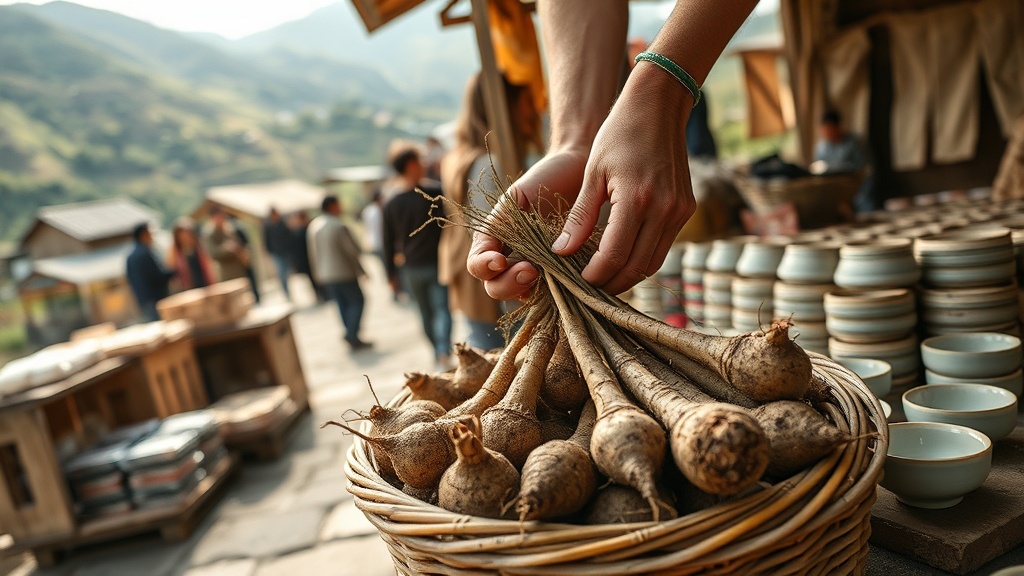The Hoengseong Deodeok Festival connects local economy and culture around deodeok (a Korean mountain root used like a health food).
At its core are hands-on digs and tastings of deodeok grown in clean Hoengseong, Gangwon Province.
Visitors meet local vendors, creating income and reinforcing community identity.
However, clear challenges remain: transport, environmental pressure, and the risk of over-commercialization.
“One Root, One Local Breath”
Overview
This is not just another farm fair.
Since its first event in 2012, the Hoengseong Deodeok Festival has grown into a signature local festival.
Every year in Cheongil-myeon visitors can dig deodeok, sample deodeok dishes, buy regional specialties, and enjoy cultural performances.
The festival clearly aims to promote the quality of deodeok and Hoengseong’s image as a clean, rural area.
Key point: Reviving the local economy through deodeok experiences and sales is central.
Hoengseong is known as one of Korea’s biggest producers of deodeok and supplies a large share of the national market.
Deodeok contains saponins and inulin, compounds often discussed for their health benefits; studies have suggested dietary roots can support digestion and overall well-being (though results vary).
The festival communicates both the agricultural value and food culture tied to deodeok.
Therefore, the event serves as a direct touchpoint where consumers meet producers through hands-on experiences.
Historical context
This is a deeply rooted local brand.
Starting in 2012, the festival grew around a single local resource and expanded its offerings over time.
What began as small-scale, experience-focused programming gradually added more events and drew larger crowds.
Recently, organizers have reported annual visitation in the tens of thousands and short-term economic spillovers.
Summary: Built history and brand identity powered the festival’s growth.
The festival’s rise reflects growing consumer interest in health foods and experiential tourism.
Local government tourism strategies and strong participation from merchants and farmers have also expanded the scale.
However, as the event grew, operational complexity, safety concerns, and environmental strains became visible.
These emerging issues force a reassessment of the festival’s long-term sustainability.

What the festival delivers
The festival delivers concrete local benefits.
It offers direct income opportunities for farmers and small businesses through sales, booth fees, and paid experiences.
These revenues temporarily boost local income and feed into the regional economy.
Moreover, the festival raises the brand value of Hoengseong, leaving potential long-term gains for tourism and agricultural sales.
Core idea: The festival generates both immediate revenue and longer-term brand value.
Turning deodeok into an experience-based product is the festival’s biggest achievement.
Promoting deodeok as a health food has also raised consumer interest.
As a result, the festival functions not only as entertainment but as an economic bridge tied to agriculture.
However, maintaining that value requires professional management and sustainable planning.
Arguments in favor
The positive effects are clear.
First, the festival has a direct economic impact: sales and experience fees translate into real income for farmers and small businesses.
Second, it strengthens place branding: naming the festival after deodeok links the product to Hoengseong’s identity.
Third, it has educational and cultural benefits: urban visitors learn where food comes from and gain practical knowledge about farming and local cuisine.
Summary: The festival creates assets in economic, cultural, and educational terms.
For example, one recent year reported roughly 25,000 visitors and sales in the range of hundreds of millions of won (roughly $150,000–$450,000), demonstrating how a short event can raise local income.
This shows the festival can act as an economic catalyst. Promoting deodeok’s supposed health benefits has helped move consumers toward purchase. Hands-on programs tend to increase repeat visitation and lengthen stays, which then benefit lodging and food services.
From a policy standpoint, the festival aligns with regional development goals. Local governments can use resource-based tourism to attract external spending and create internal economic circulation. Thus, the event can be more than a one-off celebration; it can be a development tool.
Arguments against
But the downsides are significant.
First, environmental impact and resident inconvenience are real risks.
Large crowds can increase waste, noise, and damage to natural areas; weak infrastructure causes traffic jams and safety problems.
Second, commercialization can erode the festival’s original purpose. As outside commercial interests grow, the local character and traditions risk being sidelined.
Summary: Visitor growth brings costs that must be carefully evaluated.
Indeed, some visitors and residents complain about congestion and crowded sites. Waste management strains local government resources and can lead to long-term restoration costs. If external firms dominate, local farmers and vendors may see their share of revenue shrink.
Moreover, operating the festival requires budget and manpower. If the economic returns do not compensate for these inputs, sustainability becomes doubtful.
On the cultural side, repetitive programming can dull the festival’s originality. Routine events risk losing creative local expression and, over time, visitor interest. Therefore, festival management must balance economic gain with cultural preservation and environmental protection.
Balance and improvement
A sustainable model must be designed.
First, adopt eco-friendly operations: set visitor limits, strengthen recycling, and manage routes to prevent habitat damage.
Second, protect local stakeholders’ interests: allocate priority sales areas and design transparent revenue-sharing to reduce commercialization conflict.
Main proposal: Environmental protection plus guaranteed local benefit are keys to continuity.
Also, diversify programming to avoid repetition. For example, expand educational experiences, partner with local artists for performances, and introduce seasonal themes.
At the same time, create measurable indicators to evaluate the festival’s outcomes and inform policy decisions.
These improvements will require short-term investment, but they can pay off by stabilizing the local economy and strengthening the festival brand over time. Ultimately, both residents and visitors stand to gain from a sustainable approach.
Comparing local examples
Comparison is a starting point for learning.
Successful regional festivals tend to be locally led and clearly value-driven.
For instance, long-running events centered on a single crop usually succeed when producers, local government, and merchants cooperate.
By contrast, festivals that shift to outside commercial control often lose identity and visitor interest.
Summary: Benchmark others, but adapt strategies to local realities.
Rather than copying a one-size-fits-all model, Hoengseong needs tailored strategies that reflect geography and culture. Strengthening local governance and transparency in festival management is important. Long-term plans should also account for climate change and fluctuations in agricultural conditions.

Policy recommendations
Institutional support is necessary.
Local government should create rules and funding to secure the festival’s public purpose and sustainability.
Priority measures include budget support, safety management, environmental protection, and transportation infrastructure improvements.
Also, develop objective metrics to measure festival outcomes and enable evaluation.
Policy point: Safety, environment, and transparency must come first for long-term continuity.
To do this, form a local council including farmers, merchants, residents, and officials to co-design and co-manage the festival. Additionally, link the festival to year-round programs that expand sales channels for regional goods so benefits continue after the event ends.
Conclusion
The core issue is balance.
The Hoengseong Deodeok Festival is an important resource that offers economic, cultural, and educational value.
Yet growth has revealed problems around transportation, environment, and commercialization that need clear remedies.
Therefore, environmental protection and guaranteed local benefits must go hand in hand for a sustainable festival.
In short, the festival’s strengths lie in income generation and brand building, while its weaknesses are environmental costs and commercialization risk.
Finding the right balance is Hoengseong’s task.
How do you think a local festival should evolve to benefit both the community and visitors?